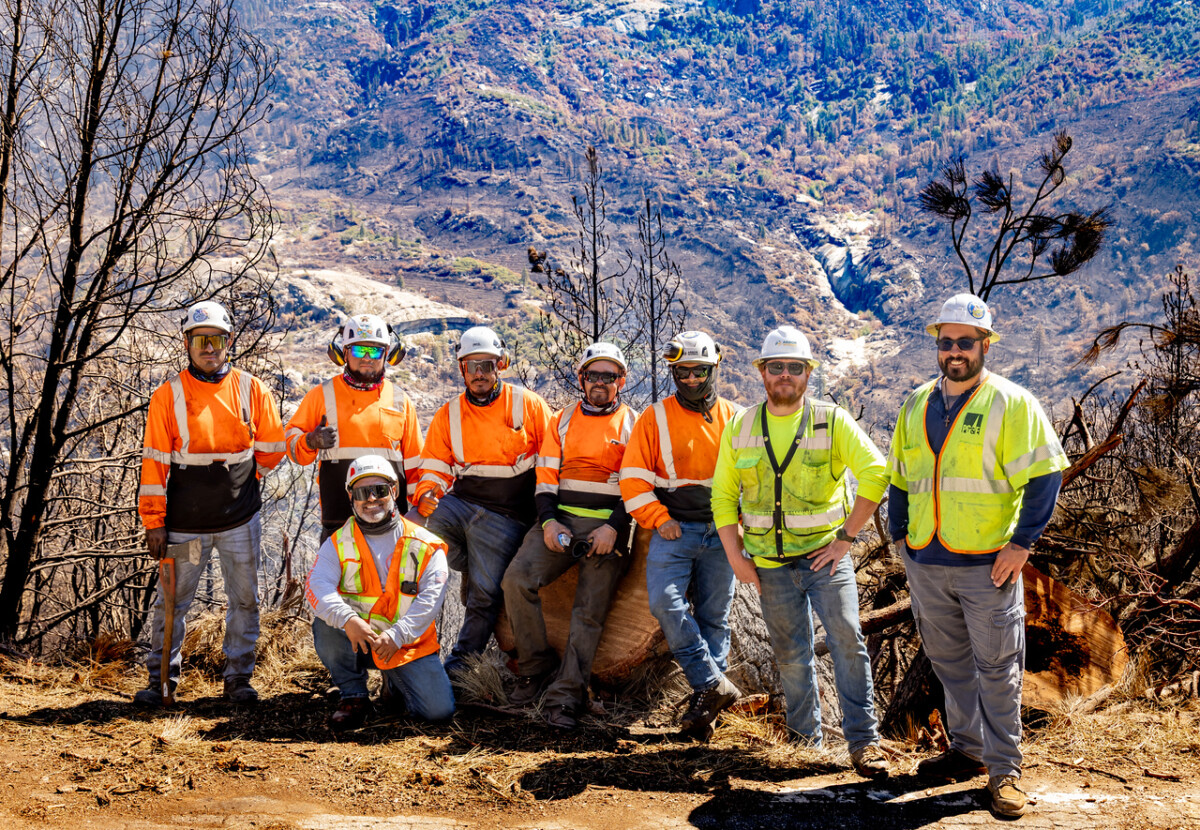
IBEW 1245 tree crews from Arbor Works at the Garnet Fire burn zone in the Sierra National Forest. These crews are removing hazard trees to restore safe access and protect power lines. Kneeling in front: Arbor Works Field Foreman Hugo Uribe.
When the Garnet Fire tore through Fresno County’s Sierra National Forest last month, it left behind a charred landscape, downed trees, and damaged infrastructure. Although containment has now reached 100%, the work of restoring the area and protecting the grid is far from over.
That’s where IBEW 1245 members come in — including line clearance tree trimmers.
Every day, nearly 20 tree crews — including Arbor Works, Rancho Tree Service, Wright Tree Service, and PG&E vegetation crews — are working along line crews, operators, and traffic control to restore safe access and protect the power coming out of the Helms hydroelectric plant at Wishon Reservoir, at an elevation of nearly 6,000 feet.
First Site: Clearing a 250-Year-Old Hazard
On the east side of the fire zone, IBEW 1245 visited an Arbor Works crew assigned to hazard tree removal. Perched high above the canyon and within sight of PG&E helicopter staging areas, the crew was working on a massive pine, estimated at more than 250 years old.
The tree was burned and unstable, within striking distance of the lines. Arbor Works Field Foreman Hugo Uribe, who has been in the trade since 1998 and was part of the first tree company organized into IBEW 1245, was overseeing the removal. He directed how the crew bucked and moved the sections safely, keeping the job moving step by step.
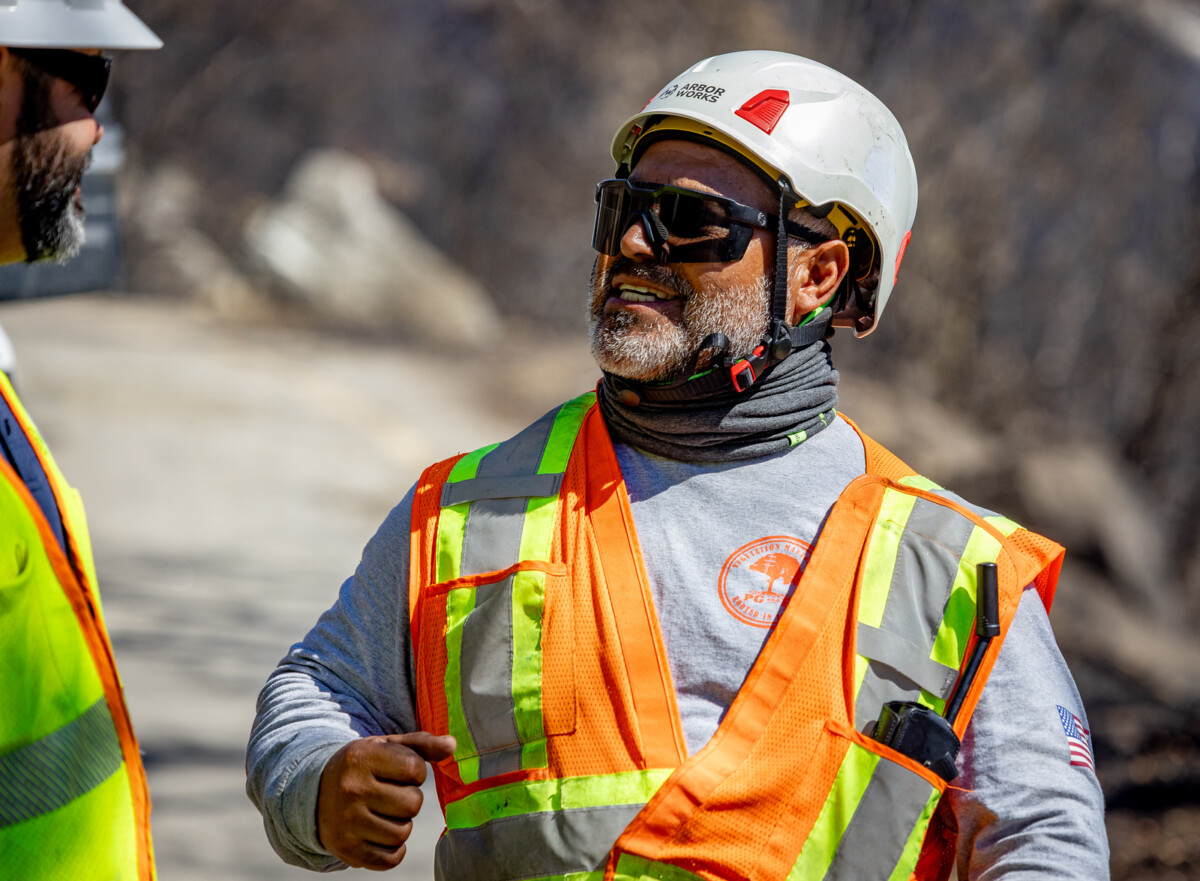
Arbor Works Field Foreman Hugo Uribe shares a moment with IBEW 1245 Senior Business Rep Francisco (Cisco) Ferreyra.
When asked if he enjoys the work, he smiled and said: “My dad did this work before me, and he told me, if you like your job, you never work. That’s how I feel.”
With precision and speed, the crew fired up their chainsaws, bucked and limbed the tree, and had the roadway cleared within an hour, opening the way for PG&E trucks and equipment.
Second Site: Teamwork in Action
We then followed the Arbor Works crew to a second site where another hazard tree stood within strike potential to the only road connecting staging yards, helicopter pads, and crews heading in and out of the canyon.
To control the fall, a crew member launched a line into the canopy using a “big shot” sling shot device, setting a tag line so the tree could be guided safely once the cuts began. After the chainsaws did their work, Arbor Works equipment operator Sean McClinden brought in his skid steer to clear the road.
McClinden has been doing this work for four years, after previously working in the oil and gas fields. What he likes most, he says, is both the equipment and the bigger picture. “There’s something patriotic about building America’s infrastructure… you’re doing it for the country and for the people,” he said. “Anytime you mix in Tonka trucks, hard work, and good pay, and you can’t go wrong,” he added grinning.
As he’s gotten older, McClinden says he’s also come to value what the union has meant for him and his family. “The benefits that 1245 has fought for really matter for my family and I,” he said.
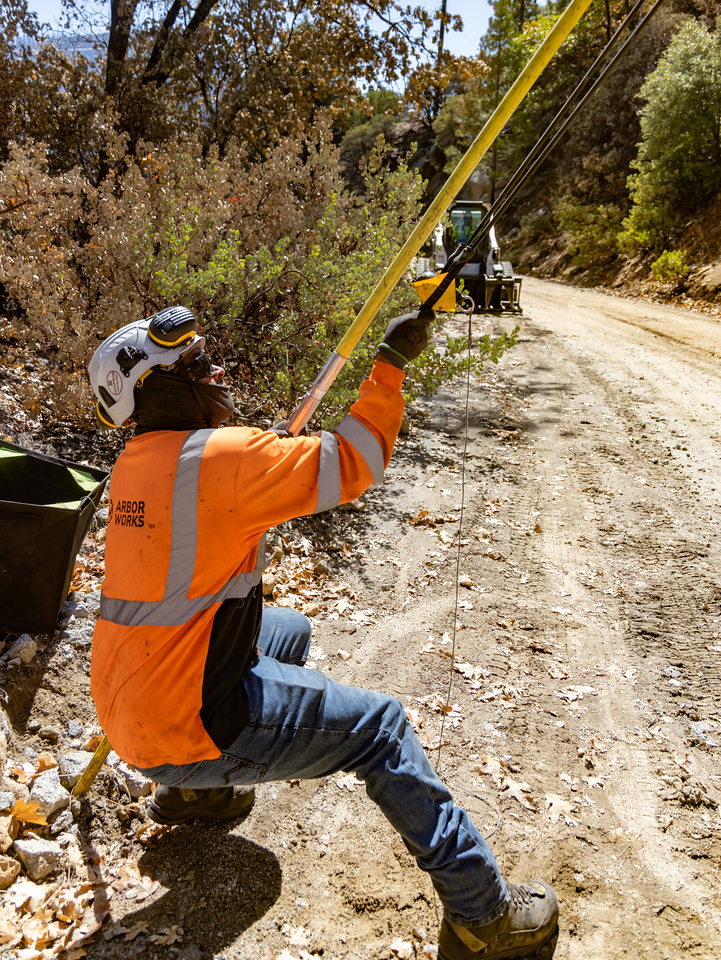
Arbor Works tree trimmers use a “big shot” sling to set a tag line in the canopy. The line helps guide the fall of a hazard tree as part of the Garnet Fire recovery work.
PG&E Crews and Traffic Control
While tree crews cleared hazards, PG&E line crews worked quickly nearby to rebuild the burned power lines. New wire was already strung in sections, and at a staging area high above the canyon, crews were busy preparing material to replace what was lost in the fire. Their work ensures customers throughout the service area don’t go without power in their homes and businesses.
Supporting all of it is traffic control, essential to keeping the roads safe as crews and equipment move constantly up and down the mountain. Erik Valadez, a PG&E traffic control worker assigned to Arbor Works, summed it up simply: “It’s pretty cool to be part of all the lines of work PG&E does. We get to see it all and help keep everyone safe.”
Union Pride
“Tree trimmers do great work in some of the toughest conditions, and they deserve strong representation,” said 1245 Senior Business Rep Francisco (Cisco) Ferreyra, a tree trimmer himself with 19 years in vegetation management. “I’m proud to be one of them, and even prouder to stand up for these members every day.”
The recovery effort will continue for months as crews contend with rugged terrain, long travel times, and the changing weather of the Sierra. But whether climbing, cutting, operating, or directing traffic, IBEW 1245 members are proud to be on the front lines of fire recovery, protecting California’s grid and the families and businesses who depend on it.
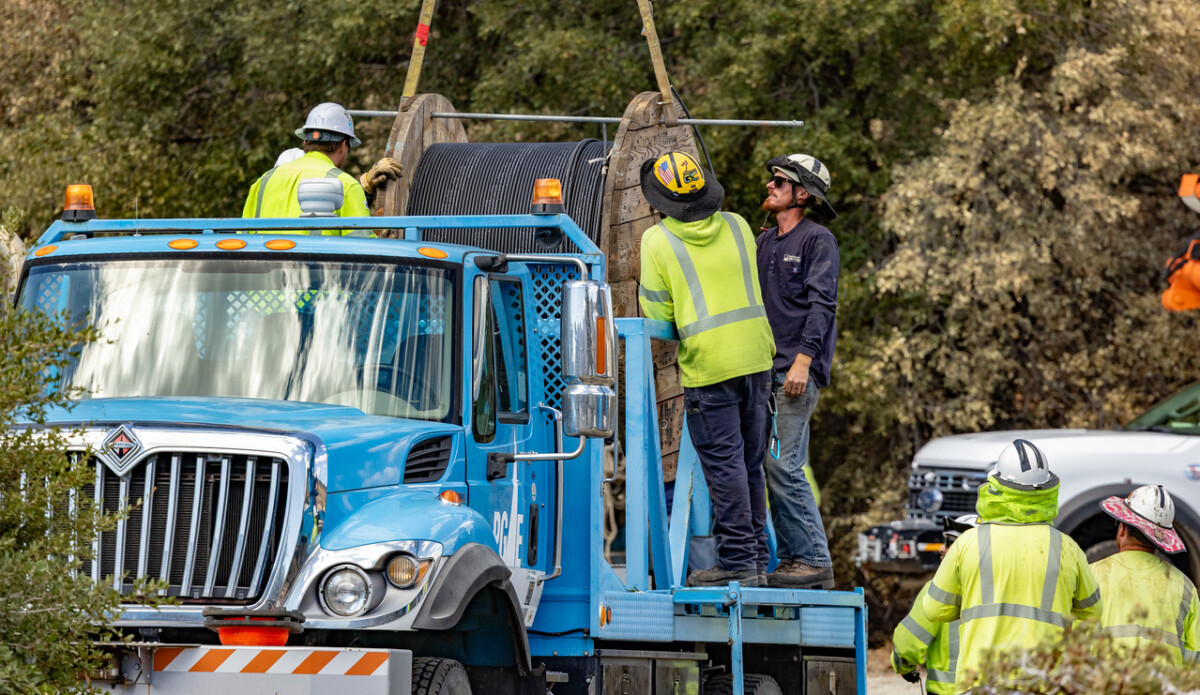
At the staging area, IBEW 1245 crews ready their equipment — preparing reels of line and gear for the long days of restoration work ahead.
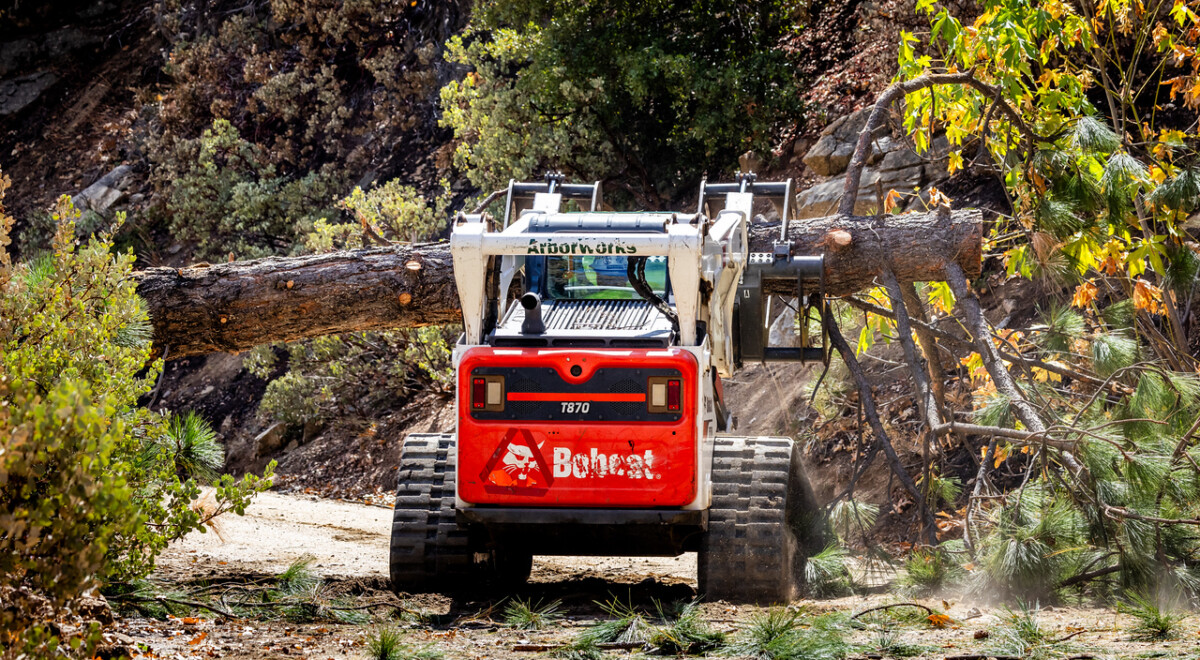
Sean McLinden maneuvers heavy equipment to clear a downed tree

An IBEW 1245 tree trimmer keeps watch as heavy equipment moves a freshly cut pine, ensuring the work is carried out safely and efficiently.

Rebuilding the grid is patriotic work, done for the good of the country and the people.

An Arbor Works trimmer methodically bucking a felled tree into manageable sections

After bringing down the tree, a crew member carefully makes his way down the steep hillside, chainsaw in hand.

With sawdust flying, an Arbor Works tree trimmer makes the precision cut that will bring down a hazard tree, part of the careful and dangerous work to clear fire-damaged terrain.

Arbor Works equipment operator Sean McLinden, an IBEW 1245 member, pauses between tasks during Garnet Fire recovery.

Arbor Works climbers carefully secure ropes in place before making the cut, ensuring the hazard tree comes down safely and under control.

Arbor Works crew members secure tag lines into a burned tree to control its fall before cutting — a critical safety step in hazard tree removal during Garnet Fire recovery.

An Arbor Works tree trimmer bucks sections of a massive hazard pine with a chainsaw, while equipment operator Sean McClendon stands by with a skid steer to clear the road

An IBEW 1245 tree trimmer makes his way through the burn zone with saw in hand, part of the crews tackling hazard trees left behind by the Garnet Fire in the Sierra National Forest.

IBEW 1245 member Sean McClinden, equipment operator, keeps his eyes on the job as he clears hazard logs with his skid steer.

IBEW 1245’s Sean McLinden works with focus and precision, moving heavy timber safely out of the burn zone.

PG&E line crews stage equipment high above the reservoir — a rugged, hard-to-reach site deep in the Sierra where every step of fire recovery takes grit and teamwork

Arbor Works crew members put their strength into the ropes, making sure the tree comes down exactly where it’s supposed to.

IBEW 1245 tree trimmers sworking together on steep terrain in the Garnet Fire burn zone.

An Arbor Works operator uses a Bobcat skid steer with a grapple attachment to haul away a massive burned log.

IBEW 1245 tree trimmer works carefully through thick pine branches

Two saws, one mission — keeping the work moving and the roads clear.

Arbor Works equipment operator uses a skid steer with a grapple attachment to clear a massive hazard log from the roadway in the Garnet Fire burn zone, keeping access open for PG&E crews and heavy equipment.

Crew members lend a hand to pull their coworker back up the slope after securing a hazard tree

Arbor Works tree trimmers, members of IBEW 1245, buck and limb a massive 250-year-old pine that came down across the road in the Garnet Fire burn zone.